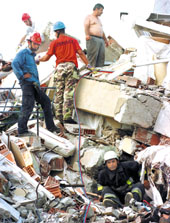|
|
|



News about the Earthquake in
Turkey-Tuesday August 17
Tuesday August 17 2:28 AM ET
 IZMIT, Turkey
(Reuters) - A powerful earthquake measuring 6.7 on the Richter scale rocked
western Turkey Tuesday, killing more than 100 people and injuring hundreds
others.
IZMIT, Turkey
(Reuters) - A powerful earthquake measuring 6.7 on the Richter scale rocked
western Turkey Tuesday, killing more than 100 people and injuring hundreds
others.
Frequent reports of collapsed buildings in heavily populated
areas suggested that the death toll could rise.
The industrial town of Izmit, the epicenter of the quake,
seemed to be worst hit. Anatolian news agency said many people had also
died in the cities of Bursa, Istanbul and Eskisehir.
Witnesses said rescue teams were struggling to reach
residents buried under dozens of collapsed .Earthquakes of more than six
on the Richter scale can cause widespread damage in built up areas.The
quake hit at 0020 GMT when most residents were asleep. ''It was very powerful.
We were shaken out of our beds. Everyone is now out in the streets,'' said
resident Mehmet Cankaya.
Istanbul was plunged into darkness as the quake cut power
to the city of some 10 million people. Thousands of frightened residents
crowded into the main streets.

Tuesday August 17 9:02 AM ET
Death Toll In Turkish Earthquake Over 800-State TV

Wednesday August 18 1:56 AM ET
 Turks Fight Against
Time, Fire After Quake
Turks Fight Against
Time, Fire After Quake
IZMIT, Turkey (Reuters) - Turks dug through rubble with
their bare hands Wednesday in a desperate search for survivors while the
world rallied to help the country ravaged by an earthquake that killed
over 2,000 people.
The official death toll had risen to 2,160 in the 28
hours since the quake rocked Turkey's populous northwest Tuesday, burying
hundreds of residents in their sleep and setting the country's biggest
oil refinery aflame.
Rescue teams dug at the ruins of a building at a naval
base in Golcuk in search of some 200 buried sailors. They recovered 20
bodies and as many wounded. A guard said he and his comrades struggled
to dig them out bare-handed.
THURSDAY, AUGUST 19, 1999 | Site Updated 4:40 AM
August 19, 1999
Over 4,000 Killed in Turkey Quake

The Bible Code about this Catastrophe
By Dr. Asali Zaki -Israel 19/08/1999
Centr Term Earthquake![]() found at ELS (-19179 ) in the Hebrew text Leviticus Chap.13:12
to
found at ELS (-19179 ) in the Hebrew text Leviticus Chap.13:12
to
Deut.Chap.13:18
Legend:
key words set encoded and related in proximity of this event:
| Earthquake to Hit In Turkey Izmit (city) 17 /August=5/Elul 1999 /(5759)= Morning Quake,Tremble the Earth Fire to Destroy, Destruction |
Thousand (plor.) Number families The Men,Persons to Die ,Death Absentee,missing Drama |


Filed at 7:54 p.m. EDT
By The Associated Press
U.S. and Turkish scientists predicted two years ago that within the
U.S. and Turkish scientists predicted two years ago that within the
following three decades, a major earthquake was likely to strike Turkey.
When the North Anatolian fault Tuesday unleashed a quake so strong
it killed more than 2,000 people and injured thousands more, the epicenter
was in the area of the port city of Izmit. The team of scientists had estimated
a 12 percent probability of a ``large event'' near that city.
Earthquake researchers say the 30-year timeframe of the study, published
in 1997 in the England-based Geophysical Journal International, is too
broad to claim a bull's eye prediction, or to have prevented the death
and destruction associated with Tuesday's 7.8-magnitude quake.
But the authors of the study said the similarities between the prediction
and Tuesday's quake demonstrated that the inexact science of earthquake
prediction is improving.
``This method can tell us something useful about how earthquakes occur,''
said James Dieterich of the U.S. Geological Survey in Menlo Park, Calif.
``But I would not claim it's far enough along to base public policy on
it.''
Another earthquake expert, Lucy Jones, said the prediction was impressive.
``They predicted that two sections of the fault would have stresses,
and one of those sections had the earthquake today,'' said Jones, scientist-in-charge
of the U.S. Geological Survey office in Pasadena, Calif.
The study predicting movements along the North Anatolian fault
was conducted by Dieterich and Ross Stein of the geological survey, as
well as Aykut Barka of Istanbul Technical University.
Searching seismic records, the scientists determined that the 500-mile
long fault, which runs east-west across Turkey, unleashed 10 earthquakes
of magnitude 6.7 or greater between 1939 and 1992.
In each case, they reported, the stress released by each tremor only
served to transfer more stress and pressure to other weak locations along
the fault. The process has helped to trigger the next quake, the scientists
said.
``Stress is calculated to be high today at several isolated sites along
the fault,'' Dieterich said. ``Increased stress means there is an increased
probability that another earthquake will occur. Our calculations narrow
it down as to where it might occur.''
Tuesday's event was the deadliest recorded earthquake to hit western
Turkey. The subsequent shaking destroyed buildings, collapsed highways
and cut off power and water to millions living along the heavily populated
Bosporus Strait.
Scientists were analyzing information from a worldwide network of seismic
monitoring stations Tuesday. Teams of investigators from U.S. agencies
and universities were preparing to fly to Turkey.
Geophysicists at the National Earthquake Information Center in
Golden, Colo., described the quake as one of the most powerful recorded
in the 20th century, rivaling the 7.9-magnitude tremor than devastated
San Francisco in 1906.
The earthquake in Turkey was initially reported as a magnitude 7.8
quake, but scientists said its intensity might be downgraded as low as
7.4 as additional measurements were taken into account.
``You don't expect one of this magnitude very often,'' said Bill Smith,
a geophysicist at the Golden center. ``It set off alarms at quite a few
of our monitoring stations around the country.'
It was a shallow tremor -- six miles deep along the North Anatolian
fault. Much like the more famous San Andreas fault in California, the North
Anatolian runs along the line where two plates in the Earth's crust grind
against each other.
Beneath Turkey, the Eurasian plate sits to the north and moves westward. The African plate is located to the south and moves eastward.
Seismic monitors recorded as many as 250 aftershocks in western Turkey in the hours after the quake.
The largest aftershock measured 5.3 in magnitude. It occurred 3 hours and 15 minutes after the primary tremor, which struck at 3 a.m. local time (8 p.m. EDT Monday), catching most people asleep.
In 1992, 485 people were killed by a 6.5 magnitude quake in Ercinzan,
located on the eastern end of the North Anatolian fault. The U.S. Geological
Survey study predicts a 15 percent probability for another major quake
in that same area in the next 30 years.